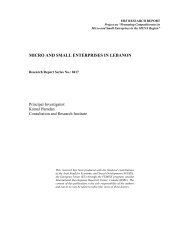View - ResearchGate
View - ResearchGate
View - ResearchGate
Create successful ePaper yourself
Turn your PDF publications into a flip-book with our unique Google optimized e-Paper software.
and institutional weaknesses (Rodrik; 1991). Certain structural characteristics such as poor<br />
financial development, labor market restrictions, inadequate laws, and pro-cyclical fiscal<br />
policy, are bound to worsen the impact of volatility and uncertainty on a country’s economic<br />
growth (see Caballero; 2000, and Hnatkovska and Loayza; 2005).<br />
On the empirical front, Ramey and Ramey (1995) find a negative relationship between<br />
volatility and growth for a sample of 92 countries as well as in a sample of OECD countries.<br />
Although Aizenman and Marion (1999) find no evidence of a relationship between<br />
investment and overall volatility and they trace the cost of volatility directly to uncertaintyinduced<br />
planning errors of firms, they do find that volatility is correlated with investment<br />
when it is disaggregated as public and private.<br />
Finally, Norrbin and Yigit (2005) examine the robustness of Ramey and Ramey’s results to<br />
the time specification with a slightly different set of countries. Their results are sensitive to<br />
the selection of countries, but a centered-moving-period volatility provides a robust negative<br />
correlation with growth even though it is less robust for OECD countries. Fountas et al.<br />
(2004) examine the relationship between output variability and output growth using quarterly<br />
data from 1961 to 2000 for Japan. Using three different GARCH-model specifications<br />
(Bollerslev's, Taylor/Schwert's, and Nelson's EGARCH), they find robust evidence that the<br />
"in-mean" coefficient is not statistically significant, which implies that output variability does<br />
not affect output growth.<br />
Although the link between growth volatility and growth has recently been the focus of many<br />
theoretical and empirical studies, the results are inconclusive regarding the direction of the<br />
effect, and various possible transmission variables causing both negative and positive impacts<br />
have been suggested. To the best of our knowledge, however, no study has explicitly assessed<br />
the role of growth volatility on a set of variables that are crucial to growth itself (we call them<br />
transmitting variables), except for the role played by investment. In this paper, we contribute<br />
to the literature by analyzing the impact of growth volatility on growth, taking into account a<br />
set of transmission variables. In this context, we focus on Total Factor Productivity growth<br />
(TFP), investment (as a ratio to GDP), and employment generation (employment growth).<br />
We also consider the exchange rate (percentage of change in the real exchange rate) as a<br />
possible transmission variable. The exchange rate has a detrimental effect on developing<br />
countries due to the high debt and inflationary pressures of these countries.<br />
This study first uses a version of the Autoregressive Conditional Heteroskedasticity (ARCH)<br />
method and quarterly Turkish data to empirically investigate the relationship between growth<br />
volatility and growth. Turkey provides a good environment for assessing this relationship,<br />
since it had high and persistent inflation along with an unstable economic and political<br />
environment for more than three decades.<br />
Our findings suggest that the effect of growth volatility on growth is negative, which supports<br />
the theoretical literature suggesting a negative relationship and the empirical findings of<br />
Ramey and Ramey (1995). An additional contribution of this paper is that the negative<br />
impact is shown to be working through the adverse effect of growth volatility on TFP,<br />
investment, and exchange rates for Turkey. The remainder of the paper is organized as<br />
follows: Section 2 presents the model, Section 3 discusses the data, Section 4 outlines the<br />
results, and Section 5 concludes.<br />
2. Modeling<br />
Modeling growth is a difficult task in time series analysis. A number of variables affect<br />
growth in a structural (behavioral) model framework, and problems with this strategy such as<br />
low degrees of freedom and endogeneity of the explanatory variables arise. As a solution,<br />
Sims (1980) suggests using lag values of dependent variables as explanatory variables (vector<br />
3

















